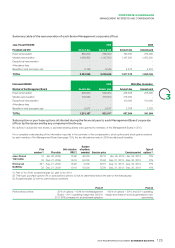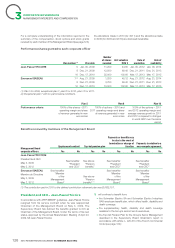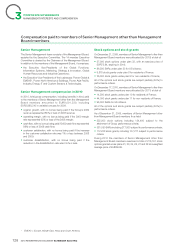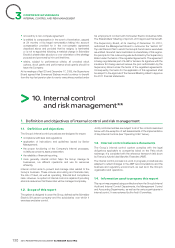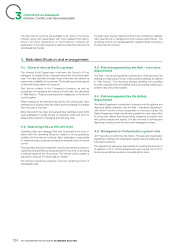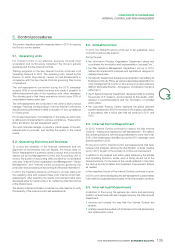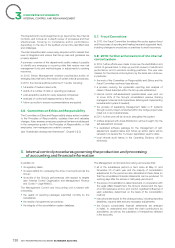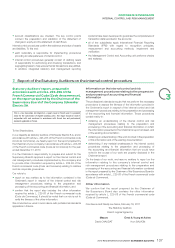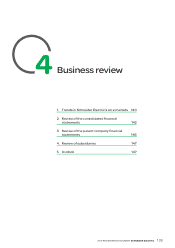APC 2010 Annual Report Download - page 134
Download and view the complete annual report
Please find page 134 of the 2010 APC annual report below. You can navigate through the pages in the report by either clicking on the pages listed below, or by using the keyword search tool below to find specific information within the annual report.
CORPORATE GOVERNANCE
3INTERNAL CONTROL ANDRISKMANAGEMENT
•drafting, updating and distributing the necessary documents for
producing quality information.
The unit drafts and updates:
•a glossary of accounting terms used in the reporting package,
including a defi nition of each term;
•the chart of accounts for reporting;
•a Group statutory and management accounting standards
manual, which includes details of debit/credit pairings in the
consolidation system;
•a Group reporting procedures manual and a system user’s guide;
•a manual describing the procedures to be followed to integrate
newly acquired businesses in the Group reporting process;
•an intercompany reconciliation procedure manual;
•account closing schedules and instructions.
The Management Control and Accounting unit monitors the reliability
of data from the subsidiaries and conducts monthly reviews of the
various units’ primary operations and performance.
The Finance and Control – Legal Affairs Department oversees tax and
legal affairs and insurance, to provide comprehensive management
of these risks.
Treasury and fi nancing management is almost completely centralised
within the Corporate Treasury Center, which issues guidelines on
fi nancial risk management and payment security.
The Corporate Treasury Center also reviews balance-sheet changes
and fi nancial risks facing the Group’s companies on an annual basis
during formal fi nancial review meetings.
Procedures for managing financial risk are described in “Risk
Factors.”
2.5. Operating Divisions and operating units
The Operating Division management teams play a critical role in
effective internal control.
All Group units report to one of the Operating Divisions, which are
headed by an Executive Vice-President, supported by a fi nancial
controller.
The Executive Vice-Presidents of the Operating Divisions sit on
the Executive Committee, which is chaired by the Chairman of the
Management Board. The fi nancial controllers report to the Internal
Audit and Internal Control Departments.
Within each division, the management team organises control of
operations, ensures that appropriate strategies are deployed to
achieve objectives, and tracks unit performance.
A Management Committee led by the corporate Management
Control and Accounting unit reviews the transactions of the Divisions
and businesses on a monthly basis.
The Operating Divisions have teams of internal controllers who
organise training on Key Internal Controls for the units within their
scope and analyse the quality of the internal control self-assessments
(including ratings and action plans) returned by the units.
They detect internal control issues that require action plans in some
or all of the units under their responsibility. They also identify units
that need specifi c assistance and either implement or oversee the
implementation of the appropriate support.
Lastly, the internal control teams offer suggestions for enhancing and
updating the Key Internal Controls.
2.6. Global Functions (Human Resources,
Purchasing, Manufacturing, Supply Chain,
Information Systems, etc.)
Schneider Electric centralises decision-making and risk management
at the corporate level through specifi c bodies such as the Group
Acquisitions Committee (see “Risk Factors”), by combining certain
functions within the Finance and Control – Legal Affairs Department
(see above) and through dedicated Global Functions.
An Innovation and Technology Council meets monthly to ensure
cross-functional coordination among the Global Function for
innovation and new products.
The Human Resources Department is responsible for deploying
and ensuring the application of procedures concerning employee
development, occupational health and work safety.
The Purchasing Department is responsible for establishing guidelines
concerning purchasing organisation and procedures; relationships
between buyers and vendors; and procedures governing product
quality, service levels, and compliance with environmental standards
and Group codes of conduct.
The Global Functions also issue, adapt and distribute policies, target
procedures and instructions to units and individuals assigned to
handle specifi c duties.
The Global Functions have internal control correspondents who work
with the Internal Control Department to establish and update the Key
Internal Controls deployed across the Group.
They analyse the results of self-assessments concerning the Key
Internal Controls that fall within their Function’s scope, identify internal
control issues that require action plans and either implement or
oversee the implementation of these plans.
2010 REGISTRATION DOCUMENT SCHNEIDER ELECTRIC132





